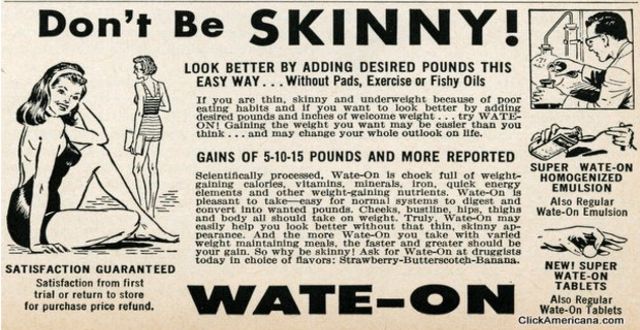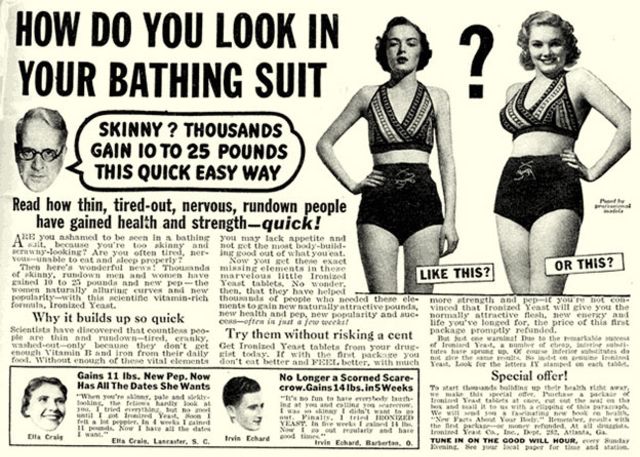Vintage ads promoting weight gain for women, 1930s-1950s
 •
by
•
by Clark.Kent

These vintage advertisements, published in magazines and newspapers from the 1930s to the 1960s show how weight gain was aspired to then as firmly as we today aspire to weight loss.
The ads tout scientific ways to “add attractive pounds and inches” (a complete oxymoron in this day and age) and “add glamorous curves to your figure.” And it wasn’t about health: the ads make it clear that being skinny or slender is the least attractive look.
“If you want to be popular, you can’t afford to be skinny!” announces one ad aimed at females. Another features a man lamenting, “A skinny man hasn’t a chance… I wish I could gain flesh.”
Another ad, for Ironized Yeast tablets, shows a lady in a bikini accompanied with the quote: ‘Men wouldn’t look at me when I was skinny… But since I gained 10 pounds this new, easy way, I have all the dates I want.’ In fact, much of the time the secret of the weight gain products was “ironized yeast.”

After the end of the Victorian Era, the ideal body image fluctuated. Things took an interesting turn in the 1920s, where a boyish figure, flat chest with a short hair bob was the idealized look of women. Androgynous was the theme, as they wanted to form a stronger identity for themselves.
It was all about curves in the 1940s. With WWII, women again moved into traditionally male roles, but softer materials such as silk and nylon saw the ideal body shape sexualized – big breasts, slim waists, and swelling hips.
The 1950s took the 1940s ideal and glamorized it. Breasts were full, hips were wide and waists were small. In the post-war boom, beauty products and fashion options opened up and there was an expectation of flawless skin and perfect hair. Women such as Marilyn Monroe, Grace Kelly, and Audrey Hepburn personified the opulent ideal.
Yet again the fashion industry demonstrated the real reason that the ‘dream body’ had changed once more. They advertised sweetheart necklines and circle skirts as a way to appear curvier and used models like Marilyn Monroe to demonstrate their effects, prompting women everywhere to buy their products on a large scale.
By the time the supermodel Twiggy debuted in the United States in 1966, the trend toward increasingly slender bodies had taken hold.
Playboy centerfolds and Miss America pageant winners all showed a decrease in body weight and hip size, and an increase in waist size, bust size, and height between the 1960s and 1980s. By the mid-1990s, this female beauty ideal had become synonymous with the thin ideal.




Comments
o7
first
Successfully transferred 400 item(s) to shefutzu.
pole no reclamada
Successfully transferred 200 item(s) to windows2012server.
VOTE GOOD LUCK 🙂
Successfully transferred 200 item(s) to Zoran I Makedonski.
o7
Successfully transferred 200 item(s) to Napoleon54.
Ο7
Successfully transferred 200 item(s) to anastasismel.
V7
Successfully transferred 200 item(s) to Ivan Petrof.
TIMES CHANGE....
Successfully transferred 200 item(s) to Dr Druid.
о7
Successfully transferred 200 item(s) to Cromarty 0.
o7
Successfully transferred 200 item(s) to Anacasa.
[removed]
o7
Successfully transferred 200 item(s) to Lady Moon4.
o7
Successfully transferred 200 item(s) to Joker from Bosnia.
interesting
Successfully transferred 200 item(s) to Burkotun.
Surreal ads! 😃
(No need to send anything!)
tx for ur support
That's phat
Successfully transferred 200 item(s) to The Real Elefantescu.
is it just me or can you not sell cc for .001 gold?
Successfully transferred 200 item(s) to Code-Y.
))
General trend today is lose weight. Food is mostly more calorie rich.
V + c
Successfully transferred 200 item(s) to Select28.
old vote. I'll me long legs
Successfully transferred 200 item(s) to Suujiku.
I have been trying to loose 3 or 4 kilos for some years now. starving my self and not drinking even water. I do not know how to loose weight. I would not like to be fat. i prefer the girl 1 that is skinny.
From side to side... too far